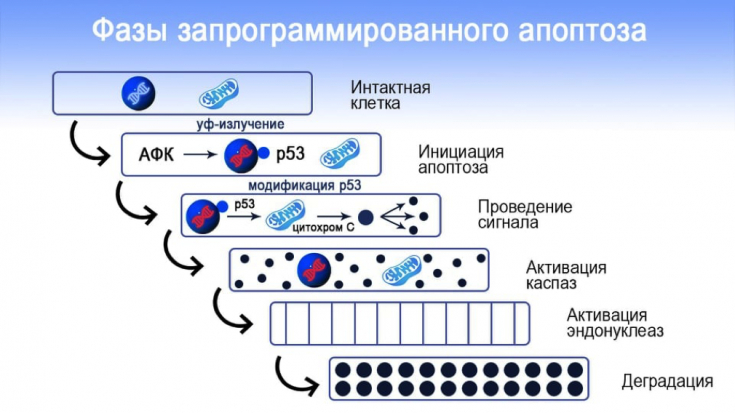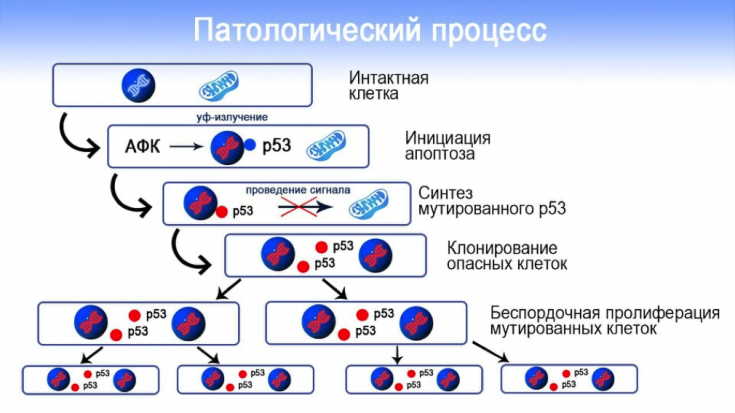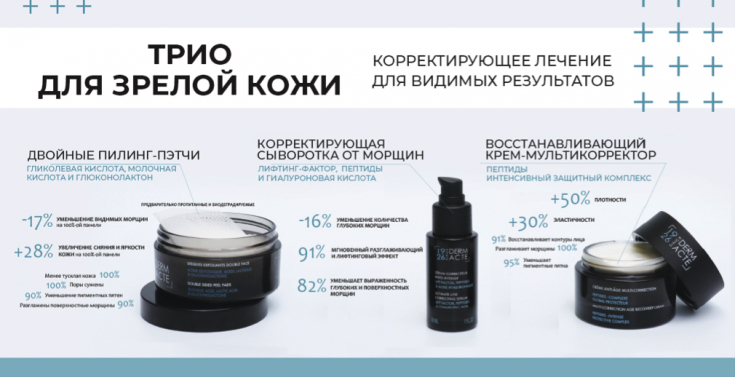There are many reasons for accelerated pathological aging of the skin. Surprisingly, but 80% of breakdowns in skin cells are due to the influence of exogenous environmental factors. Skeptical attitude towards the expression "beautiful tan"; at the dermatocosmetologist not by chance. Unfortunately, tanned skin has nothing to do with health and beauty. Along with chronic aging, which is inevitable for our skin, sunbathing speeds up pathological processes in the skin, which can lead to serious complications, the most formidable of which is skin cancer.
Read about the mechanisms that regulate cell division and skin renewal processes at estet-portal.com from Irina Kadkalenko, pharmacist, cosmetologist, founder of the dermatological clinic for women's health "Efira".
- cellular mechanisms of regulation of skin renewal
- apoptosis as a way to control the quantitative composition of cells
- photodamage as the main factor in stimulation of apoptosis
Cellular mechanisms of regulation of skin renewal
Youth and elasticity of the skin directly depend on its ability to renew itself in time. To do this, the cells must work together, their birth and death are always subject to strict rules. The healthiest example of programmed cell death is apoptosis. There are about 60 mechanisms in skin cells that protect the DNA of healthy cells for subsequent cloning.
Follow us on Instagram!
Apoptosis ˗ is one of the most studied mechanisms for regulating the quantitative cellular composition, as well as a reliable system for protecting skin cells from malignant transformation. Cancerous tumor cells lose their ability to undergo apoptosis and continue to divide uncontrollably, leading to increased tumor growth.
Apoptosis as a way to control the quantitative composition of cells
An important aspect of programmed self-destruction of the cell is the correct algorithm of the work of proteins that trigger the process of apoptosis. The correct outcome of programmed cell death depends on the coordinated work of proapoptotic signal proteins.
The most studied markers of cell apoptosis are a family of proteins, the main one being p53, which directly triggers programmed cell death.
The p53 protein is synthesized in response to exceeding certain threshold values in cellular processes. It provides answers adequate to these values, coordinates intracellular processes that determine the further fate of the cell. This protein is the central element of the regulatory system of cell division, which is of particular importance for skin cells, since the epithelial tissue is renewed in the body at the highest rate.
Follow our news on Facebook!
In the mode of such intensive work, any changes in the composition of the internal environment or external factors can lead either to excessive synthesis of the p53 protein and cell death, or to the degeneration and development of precancerous, and then cancerous diseases.

p53 has the unique ability to inhibit cell divisions in cells that have various types of DNA damage or pre-gene damage conditions. Thus, the most important function of p53 for skin cells is manifested - oncosuppressive. Apoptosis ˗ is a reliable cell population defense system capable of removing defective cells, blocking the formation of harmful ones.
Read also: Remove age spots ˗ mission accomplished!
The p53 protein is synthesized in the cell as soon as any gene breakage occurs in it. After the p53 protein undergoes specific modifications, the cell becomes sensitive to it and a cascade of reactions is triggered, leading to the division of the cell into small vacuoles, ready for digestion by macrophages.

When we talk about programmed apoptosis, it would not be superfluous to note that along with cell self-destruction, p53 protein triggers the synthesis of the most important antioxidants in the skin, such as superoxide dismutase and glutathione peroxidase. When exposed to high doses of UV radiation, the process of cellular update is disorganized. Free radicals induce massive DNA damage in cells caused by oxidative stress. cells massively undergo apoptosis.
Photodamage as the main factor in stimulating apoptosis
The life span of the p53 protein is not long at all. The prognosis for the skin will be unfavorable when the mutations affect not only individual processes in cells, but also the p53 protein itself. More than 1200 mutations of the p53 protein are known. Depending on the mutational status, it can change from an oncosuppressor form to a pro-oncogene. Just one nucleotide change can change the quality of the protein. It is no longer able to protect the skin from cancer, as the cells are no longer sensitive to the mutant protein.
Read also: Blue Light: Skin Enemy Number One
Due to the loss of sensitivity to the main proapoptotic marker, cells with dangerous DNA breakdowns lose their ability to self-destruct and begin to clone their own kind. This starts the growth of a malignant tumor. How long can skin cells resist free radical attacks and at what point can cell breakdown become dangerous? Everyone is different, so it is important to protect the skin at all times.
Clinical manifestations of photoaging are characterized by multiple disorders, many of which become irreversible. In addition to UV radiation, skin suffers from exposure to short blue waves emitted by all kinds of gadgets, low-quality hard water, unbalanced nutrition and incorrect use of cosmetics.

It is not difficult to conclude that the skin needs to be helped daily, twice a day and regardless of the number of sunny days. The most important steps in skin care are the quality removal of dead cells, neutralization of free radicals and protection from UV rays.
Photoaging is independent of age. And therein lies its greatest danger. Therefore, the procedures in the office and home care should be selected by the cosmetologist in accordance with the characteristics of the skin. All-season peelings both in the cosmetologist's office and at home have a positive effect on the process of skin renewal. Proper exfoliation is the key to radiant and healthy skin. Derm Acte peeling patches from Academie Scientifique de Beauté, presented by «Academy of Scientific Beauty», are pre-soaked patches containing an organic complex of fruit acids, lemon water , hyaluronic acid, aloe vera.
Read also: Technique for effectively removing forehead wrinkles
Peeling patches have two sides. Rough for active exfoliation, smooth for a luxurious glow. Most importantly, after applying peeling patches, you do not need to remove the remnants of the product from the skin. You can immediately apply serum and cream. Applying peeling patches is recommended in the evening.
It should also be remembered that UV radiation negatively affects the skin all year round. This is the reason for the recommendation to use products that protect the skin from the sun all 365 days a year. Particular attention should be paid to protecting the skin during periods of use of products with acids. Sun protection should only be purchased from your beautician. Beauty&Wellnes Award 2019 Best Sunscreen 365 White UV Screen by Derm Acte.

The blue light filter has become a real trend in the beauty industry. Academie has introduced a blue light filter into its Anti-Wrinkle Revitalizing Corrective Cream. When choosing home care, you should pay attention to the technology of cosmetics production. The Academie brand for its Derm Acte products, represented by «Academy of Scientific Beauty», has developed and patented a unique system for delivering active ingredients into skin cells.
Read also: How to quickly remove dark circles under the eyes
Submicron encapsulated emulsion ˗ is a modern technology allowing the components to get targeted and with optimal bioavailability into all layers of the skin, distributing evenly in it.
When choosing home care products, always trust your beautician. Then you are definitely guaranteed healthy and elastic skin!
The most up-to-date information on our YouTube-channel:







Add a comment